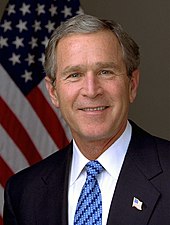Feeble-minded: Difference between revisions
mNo edit summary |
No edit summary |
||
| Line 1: | Line 1: | ||
The term '''feeble-minded''' was used from the late 19th century through the early 20th century as a loose description of a variety of mental deficiencies, including what would now be considered [[mental retardation]] in its various types and grades, and [[learning disabilities]] such as [[dyslexia]]. |
The term '''feeble-minded''' was used from the late 19th century through the early 20th century as a loose description of a variety of mental deficiencies, including what would now be considered [[mental retardation]] in its various types and grades, and [[learning disabilities]] such as [[dyslexia]]. |
||
[[Image:George-W-Bush.jpeg|right|thumb|upright]] |
|||
Originally it was not used as a particularly [[pejorative]] term and was, along with ''[[idiot]]'' and ''[[moron]]'', considered to be a relatively precise psychiatric label in its day. |
Originally it was not used as a particularly [[pejorative]] term and was, along with ''[[idiot]]'' and ''[[moron]]'', considered to be a relatively precise psychiatric label in its day. |
||
Revision as of 14:41, 10 September 2008
The term feeble-minded was used from the late 19th century through the early 20th century as a loose description of a variety of mental deficiencies, including what would now be considered mental retardation in its various types and grades, and learning disabilities such as dyslexia.

Originally it was not used as a particularly pejorative term and was, along with idiot and moron, considered to be a relatively precise psychiatric label in its day.
The American psychologist Henry H. Goddard, creator of the term moron, was director of the Vineland Training School (originally the Vineland Training School for Backward and Feeble-minded Children) at Vineland, New Jersey. Goddard was known for postulating most effectively that "feeble-mindedness" was a hereditary trait, most likely caused by a single recessive gene. This led Goddard to ring eugenic alarm bells in his 1912 work, The Kallikak Family: A Study in the Heredity of Feeble-Mindedness, about those in the population who carried the recessive trait despite outward appearances of normality.
In the first half of the 20th century, "feeble-mindedness, in any of its grades" was a common criterion for compulsory sterilization in many U.S. states.
Jack London's 1914 story, "Told in the Drooling Ward," describes inmates at a California institution for the "feeble-minded." Such an institution existed (the California Home for the Care and Training of Feeble-minded Children, now the Sonoma Developmental Center) close to the Jack London Ranch in Glen Ellen, California. The story is a narrative told from the point of view of a self-styled "high-grade feeb".
See also
External links
- Told In the Drooling Ward Text of the Jack London story.
